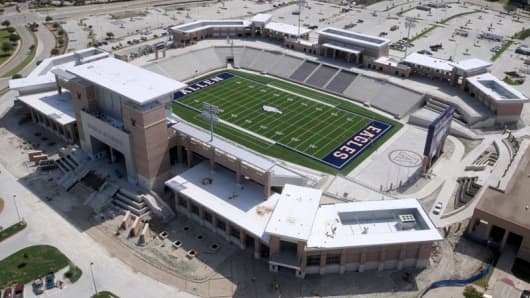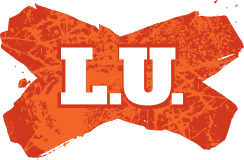https://www.cnbc.com/id/100001024
High School Sports Have Turned Into Big Business
Mark Koba |
@MarkKobaCNBC
Published 11:29 AM ET Sun, 9 Dec 2012 Updated 5:27 PM ET Tue, 11 Dec 2012CNBC.com

Source: Aerial Photography Inc. | Wikipedia
Eagle Stadium in Allen, Texas.
Naming rights for stadiums,TV and Internet broadcasting revenues, coaches with big pay days and multi-million dollar game day facilities. These types of money deals in sports are usually associated with the pros and college.
But American high schools are taking a page out of the same playbook by doing similar kinds of deals. While the money is nowhere near the pro and college level, schools are nonetheless turning their athletic programs into one of the most explosive areas in sports business, say analysts.
"It's an economic juggernaut," said Mark Conrad, associate professor of legal and ethical studies at Fordham University's school of business. "If you think about where people are on Friday nights in areas like the South and Midwest, they are at their local high school football game. It's no wonder the market for high school sports has expanded."
Conrad said the fan devotion that's fueling the business expansion is comparable to what some people feel about a company like
Apple."People love their iPhones and iPads and it's like a religion to them. It's the same with high school sports."
The money began slowly pouring into high school sports in the 1980's when local networks, along with ESPN, started featuring high school events, especially football. Budget cuts, even before the recession of 2007-09, forced many schools to seek out lucrative deals. But for some schools, the funding keeps flowing in from all sides-public and private.
For instance, a $60 million state-of-the-art high school football stadium that seats 18,000 – the money approved by voters in a local referendum - opened this past summer in Allen, Texas. Meanwhile, shoe company
New Balance paid $500,000 last year to help refurbish an existing high school football stadium in Gloucester, Mass., as well as getting the stadium's naming rights.
Similar high school stadium naming deals with local businesses have been made across the U.S., including in Lakewood, Ohio ($320,000) and Noblesville, Indiana ($575,000).
Broadcasting rights and money are also expanding. Last summer, the New York City public school system negotiated a two-year, $500,000 contract with the MSG Varsity Network — a
Cablevisionnetwork — to broadcast all types of high school athletic events.* And the California Interscholastic Federation just signed a 15-year deal with
Time Warner Cable to broadcast high school football playoff games, for $8.5 million.
"The money in sports is looking for the next generation and high school sports are huge economically. It's natural in a way that big money is going in that direction," said Robert Boland, academic chair of the NYU Tisch Center for Hospitality, Tourism and Sports Management.
It's the constant demand for any kind of high school sports product that's spurring business growth, said David Rudolph, CEO of
PlayOn, a high school sports media company.
"The number of people who go to high school is three times the number in college and almost everyone can identify themselves as a high school fan," said Rudolph, whose company broadcasts some 30,000 high school sporting events over television and the Internet. "Most people played high school sports and they love to watch it."
PlayOn became an independent company with venture capital money in 2008 after initially being part of Turner Broadcasting. Rudolph said the Atlanta based firm has a breakdown of 98 percent digital broadcasting and 2 percent television.
"There's no central high school organization like the NCAA in college, so we pay state wide school sport associations for the broadcasting rights and then license those to cable companies and get advertising fees," Rudolph said. "We're right at profit."
But as the marketplace for high school sports heats up, so too is the cost of doing business, Rudolph said.
"We pay less than six figures for the rights to high school events but they are going up in price as the competition for those rights heats up," added Rudolph.
The money from a PlayOn, ESPN, New Balance or a Time Warner goes to the local school boards and districts for them to dish out to the actual high schools. And that could be a problem, said Boland, as some schools may be more equal than others on and off the field.
While the national average salary for a high school football coach is around $39,000, in football-loving Texas, that average is more than $88,000, and one coach at Euless Trinity High School made more than $114,000 in 2011.
"In a school district, the schools will likely be competing among themselves for money," said Boland. "Some schools will have higher-paid coaches and better sport programs and they can keep getting money while leaving others behind."
For Naomi Storey, a resident of Hiram, Ga., the worry is that all the money will make a bad situation worse.
"Many kids are already putting too much emphasis on sports and not academics, "said Storey whose children and grandchildren have gone to local area high schools in this northwest section of Georgia. "And a lot of them are getting injured with broken bones and blown knees and arms."
Storey, who worked as a substitute teacher for 19 years, added that she's experienced firsthand the negative influence of money and competition at the high school level.
"My granddaughter's husband was fired last year as a football coach from one of the local high schools after 18 years because one of the highest donors felt like his son wasn't getting to play enough," Story said. "Luckily he got hired by another high school principal."
Analysts say the worry with all this money is of course what it could do to the student-athlete, the coaches and the schools under the increasing exposure to media coverage. There's pressure to perform through injuries, the danger of recruitment violations by coaches, the special treatment to schools - at the expense of others - that are deemed winners by districts.
"These are just kids really and so vulnerable in many ways," said Boland. "These high school sports have been monetized and it's not always in the best interests."
But the spotlight on high school athletics - and the money that comes with it - just continues. ESPN broadcast nationally some 24 high school football and basketball games this year while Fox Sports Florida, a regional network like FSN Pittsburgh or Comcast Sportsnet, shows a high school game every weekend live and in prime time through the season.
It just proves, said Mark Conrad, that no one should expect the money that's pouring into high school sports to get thrown out of the game anytime soon.
"There may be a saturation point to all this but right now it keeps growing. The market in high school sports keeps expanding," Conrad added. "The dedication to high school sports from all sides is endless."
*CNBC is part of NBC Universal which is majority owned by Comcast.

